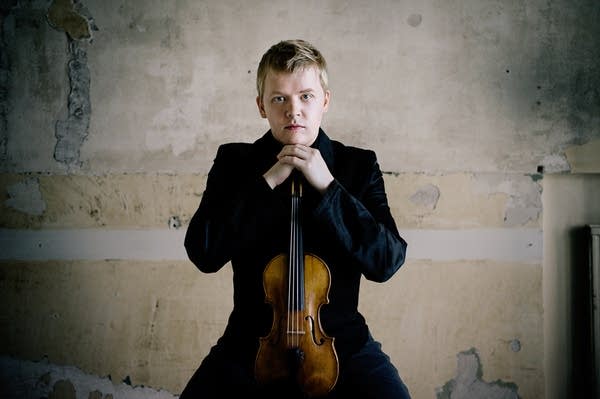
All right, I'll admit it. I'm addicted to it: the adrenaline rush, the risk, the excitement. Like a test pilot girding him or herself up for the next hair-raising flight.
For years now, I've been addicted to playing principal flute in an orchestra. And I contend that it's everything it's cracked up to be.
When I was only four or five years old, I had an idea that I wanted to play the flute. I didn't even know what one looked like: whether it was played to the side or to the front, whether it was made out of wood or metal.
I just knew that I was attracted to that sound — by turns sunny, round, cool, liquid, fluid. Sure enough, when I finally got my first flute at age nine, it was love at first breath. Then, when I got to play principal flute in my first great piece of music — I remember it was Beethoven's Eighth Symphony — at Sewanee Summer Music Festival in Tennessee when I was thirteen, I experienced the solo flute's role, soaring above the orchestra. Like flying, indeed (with the second flutist, of course, as co-pilot).
I love the flute's versatility in producing a wide palette of colors. Unlike other wind instruments, we flutists have no reed or mouthpiece defining and limiting the shape of the airstream. We can use the flexibility of our lips to produce sounds ranging from edgy to warm to hollow to smoky.
Composers know this and exploit it. My teacher, the legendary French flutist Marcel Moyse, who actually knew Claude Debussy in early 20th-century Paris, asserted that Debussy started the famous phrase for flute alone which opens his Afternoon of a Faun on a C-sharp because this note, having no keys down, has the most potential for color change.
Johannes Brahms also knew this about the flute. In the autumnal slow movement of his fourth symphony, the twisting wind writing — like a changing kaleidoscope of colors — uses the flute's glow to add warmth here and there to the earthy darkness of the wind choir.
In the last movement of Brahms' first symphony, the flute becomes a brilliant soloist, competing even with the French horn in majesty and glory. I remember playing this solo one summer at the Grand Teton Music Festival, when Phil Myers of the New York Philharmonic (renowned for his huge sound) was playing principal horn. Before the first rehearsal of the Brahms, he came up to me and playfully taunted, "So, Julie — I guess you're going to try to compete with the horn on this one…?"
"You bet," I answered.
So I love the flutist's schizophrenic role in the orchestra — now blending as a chamber musician, next rising to prominence as a soloist. And as a flutist, I feel that our best repertoire is within the orchestra. The flute has a few chamber music greats — notably works by Bach, Mozart and Debussy — but it has nowhere near the wealth of colossal masterpieces written for string quartet. Yet when you consider the orchestral composers — Beethoven, Brahms, Mendelssohn, Schubert, Schumann, Sibelius, Shostakovich — all of them have written glorious solos for the flute, embedded within the orchestral parts. In fact, I contend that the greatest wind chamber music is contained within the symphonies of these great composers. Take a Schubert symphony: the clarinet may state a theme; the oboe chimes in; the flute crowns the phrase; the bassoon weaves a countermelody. Heavenly!
As the "solo" flute of an orchestra, we experience quite a degree of autonomy. True, the occasional micro-managing conductor may try to dictate how we should play our every note. But when it comes right down to it, we are the ones making the sound in the concert! Fortunately, many great conductors appreciate an inspired spontaneous idea of interpretation emanating from a solo wind player in the midst of a concert.
Of course, with exposure there is always risk of calamity. Will I crack a staccato note? Will I find precisely the right lip position to come in exactly in tune with the oboe on that soft high E? A touch of Zen equanimity helps.
Flute is not for wimps; it takes more air than any other woodwind. Lacking a reed or mouthpiece to channel all of our air, flute is very inefficient and hence requires a huge air supply. Even jock trumpet players have been known to get dizzy when they try to blow on a flute! After a rehearsal, I feel depleted, as though I have been swimming laps or blowing up balloons for three hours. I am usually starving.
And so, for me, the essential preparation for a concert involves prodigious amounts of napping and eating, as well as warming up strategically, just enough without wearing myself out ahead of time. Around 3 p.m., I am often heard announcing that I am "gearing up for my nap." For me, the quality of the concert is predicated on the quality of the nap.
Certain violists have been known to assert that the viola section is the center of the world (i.e., orchestra). Au contraire! I maintain that the principal flute has the best seat in the house. With the string section spread out before us, the brass section behind and the woodwinds fanning out on either side, we have the quadrophonic experience par excellence.
So, you may ask, as the sopranos of the orchestra, are flutists also the divas? Probably guilty as charged.
But then, it's hard not to bask in the glow of our role — as the sunshine of the orchestra.
Flutist Julia Bogorad-Kogan became the Saint Paul Chamber Orchestra's principal flutist at the age of 22, and she combines an orchestral career with regular recital and solo performances. She also serves on the faculty of the University of Minnesota's School of Music.
Interested in writing about classical music for Classical MPR? Have a story about classical music to share? We want to hear from you!
Want to see more classical-music features and stories like this? Subscribe to Classical Post, our free, weekly newsletter to receive the latest updates from Classical MPR.
You must be 13 or older to submit any information to American Public Media. The personally identifying information you provide will not be sold, shared, or used for purposes other than to communicate with you about American Public Media programs. See Minnesota Public Radio Terms of Use and Privacy Policy.
Love the music?
Show your support by making a gift to YourClassical.
Each day, we’re here for you with thoughtful streams that set the tone for your day – not to mention the stories and programs that inspire you to new discovery and help you explore the music you love.
YourClassical is available for free, because we are listener-supported public media. Take a moment to make your gift today.












